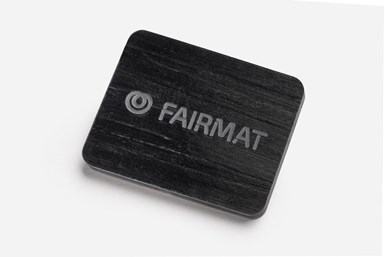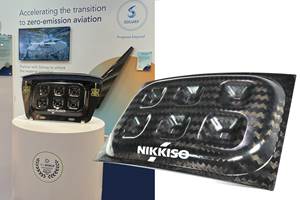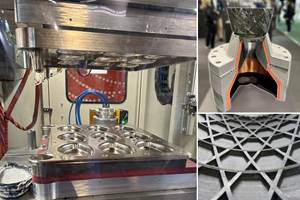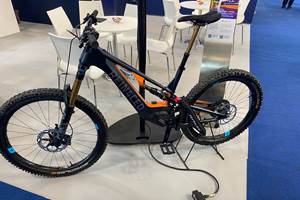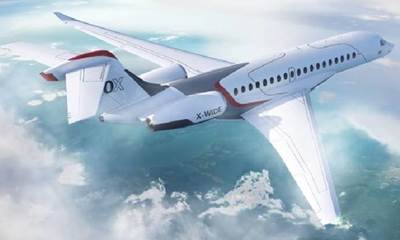Industry versatility served via novel continuous carbon fibers, prepregs
JEC World 2024: Hexcel celebrates the success of its customers with latest composites technology solutions and applications on display for the aerospace, automotive, energy, sports and marine markets.
Hexcel (Stamford, Conn., U.S.) is demonstrating its latest developments for the aerospace, automotive, energy, sports and leisure and marine industries, including a broad range of high-performance advanced composite materials and the company’s latest sustainability collaborations.
For the aerospace sector, Hexcel is launching a novel HexTow continuous carbon fiber — IM9 24K — for manufacturers seeking to maximize efficiency in primary and secondary aerospace vehicle structures. HexTow IM9 24K provides high fiber performance, translating into increased composite tensile strength, as well as the increased fiber line throughput and productivity provided by a 24K tow size.
Hexcel also presents its new, rapid-curing prepreg. Developed for the high-rate production of structural composite parts, HexPly M51 is designed for rapid hot-in/hot-out press curing. It has a 40-minute cure cycle at 180˚C, reducing production times and costs versus standard autoclave-cured prepregs. Using HexPly M51 also reduces the need for multiple sets of tooling and labor compared with conventional prepreg systems. The prepreg is fully compatible with automated tape laying (ATL), automated fiber placement (AFP) and pick-and-place processes. Moreover, it is REACH-compliant, demonstrating a mechanical performance equivalent to other state-of-the-art 180°C-cure prepregs.
Aerospace parts displayed at JEC World 2024 include a HAICoPAS aerospace demonstrator panel manufactured using novel thermoplastic and carbon fiber materials that target the low-cost assembly of structural aerospace parts. This project involved Hexcel, Arkema, Ingecal, Coriolis Composites, Pinete Emidecau Industries, Institut de Soudure and CNRS laboratories (PIMM, LTEN). Structural undirectional carbon fiber-reinforced polyetherketoneketone (PEKK) thermoplastic parts were produced out of autoclave (OOA)/in-situ and then assembled using a welding technology which can then be used to replace metal parts at a higher production rate. The demonstrator panel — made in collaboration with an industrial committee including Airbus, Safran, Daher, Hutchinson and ATC — is on display at the JEC Mobility Pavilion.
In addition, Hexcel showcases aerospace components manufactured with the latest generation of HexPly, HiTape and resin transfer molding (RTM) solutions, including composite engine pylon covers, a liquid hydrogen tank demonstrator and a low-noise Airbus H160 helicopter rotor blade developed using a range of Hexcel reinforcements, prepregs, adhesives and honeycomb materials.
Hexcel also highlights solutions for marine customers and exhibits a scale model of a 220-meter-long sail-powered cruising yacht to be created by Chantiers de l’Atlantique (CDA) for customer Accor. The masts used by the new ship for wind propulsion are manufactured using Bureau Veritas (BV)-approved HexPly M9.6 prepregs, reduce reliance on engines and cut fuel use. CDA and its consortium won a 2023 JEC Innovation Award for their work on this project.
HexPly M9.6 prepregs are also used to produce lightweight carbon fiber hydrofoil components; the company is displaying an AFS brand foil made by French company Foil and Co. Experts in the design and manufacture of composite products, AFS has chosen to offer 100% carbon foils that are designed and manufactured entirely in France.
As part of its portfolio of composite solutions for the automotive industry, Hexcel presents its prepreg and dry fabric material technologies as well as components including a sportscar wheel made in a fully industrialized high-volume production process.
In addition, Hexcel continues to develop its offering for future energy generation applications and showcases its latest carbon fiber and towpreg materials that enable a transition to lower environmental impact transport and electric engines. Hexcel hot melt towpreg materials are said to take a first step in reducing environmental footprint, focusing on performance optimization and overall reduction in composite material use.
For sustainable solutions, Hexcel is featuring a dedicated zone at its booth. On display will be Elan and Blizzard skis commercialized with HexPly Nature Range prepregs. Hexcel now offers industrial resins with a bio-derived resin content, including M49 for cosmetic applications, M79 for thick structures or low-temperature cure and M78.1 LT for fast cure. These resins offer the flexibility to be paired with natural fiber and recycled carbon fiber reinforcements.
A novel project, Hopper, is being highlighted, in which Hexel has helped to improve accessibility to sport, mobility and autonomy for people with disabilities. On display is the Hopper prosthetic running blade made of discarded aerospace carbon materials. The project uses recycled Hexcel carbon fiber prepreg from Airbus facilities. Project partners Airbus, Salomon and the 3Dx lab of Dassault Systèmes worked together with Hopper to manufacture the affordable and accessible carbon fiber running blade. The Hopper blade is easy to use, enabling sports and outdoor activities thanks to its flexible and versatile composite design.
There are also to be a collection of parts donated by Fairmat that demonstrate its 2024 JEC Innovation Award-nominated Closed Loop Ecosystem for Carbon Fiber. Fairmat’s AI-driven, software-centric technology uses robots to create 100% recycled carbon fiber-reinforced polymer (CFRP) chips using Hexcel prepreg waste. A versatile solution for diverse product applications, these chips offer low weight, strength and stiffness benefits, filling the gap in the advanced materials industry and ensuring carbon fiber doesn’t go to waste. Hexcel is proud to support Fairmat and its recycling program, with almost all its European-produced carbon fiber prepreg cutoffs avoiding landfill and being processed for reuse into commercial markets. The partnership has led to more than 170 tons of prepreg material being diverted from waste to fulfilling commercial product needs in 2023.
Visit Hexcel at Booth J41 in Hall 5.
Related Content
Recycling hydrogen tanks to produce automotive structural components
Voith Composites and partners develop recycling solutions for hydrogen storage tanks and manufacturing methods to produce automotive parts from the recycled materials.
Read MoreJEC World 2023 highlights: Innovative prepregs, bio-resins, automation, business development
CW’s Jeff Sloan checks in with JEC innovations from Solvay, A&P, Nikkiso, Voith, Hexcel, KraussMaffei, FILL, Web Industries, Sicomin, Bakelite Synthetics, Westlake Epoxy and Reliance Industries.
Read MoreJEC World 2024 highlights: Thermoplastic composites, CMC and novel processes
CW senior technical editor Ginger Gardiner discusses some of the developments and demonstrators shown at the industry’s largest composites exhibition and conference.
Read MoreJEC World 2024 highlights: Forwarding initiatives surrounding sustainability and mobility
Themes at the forefront of JEC World 2024 included solutions for mobility applications and sustainable materials, technologies and processes for composites manufacturing.
Read MoreRead Next
Hexcel to supply carbon fiber prepreg for Dassault F10X program
The Falcon F10X will be the first Dassault Aviation business jet program to incorporate high-performance carbon fiber in the manufacture of its aircraft wings.
Read MoreHexcel signs long-term manufacturing contract with Boeing
Hexcel will produce HexPEKK-100 manufactured-to-print aerospace structures, including various air flow ducting applications and other supporting elements, for the Boeing 777X.
Read MoreAll-recycled, needle-punched nonwoven CFRP slashes carbon footprint of Formula 2 seat
Dallara and Tenowo collaborate to produce a race-ready Formula 2 seat using recycled carbon fiber, reducing CO2 emissions by 97.5% compared to virgin materials.
Read More








